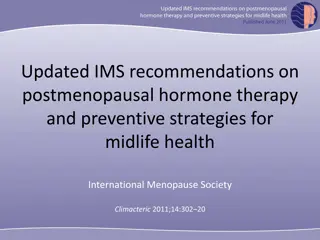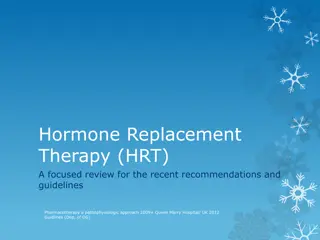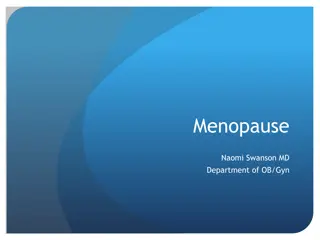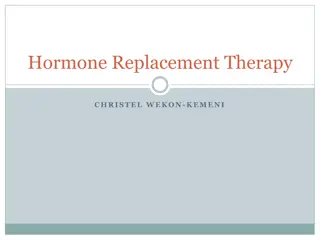
Australasian Allied Health Benchmarking Consortium Overview
"Learn about the Australasian Allied Health Benchmarking Consortium (AAHBC) and its role in standardizing allied health practitioners' activity recording in public hospitals. Discover how AAHBC promotes collaborative benchmarking practices and provides valuable input for health strategies and projects. Explore membership criteria and the consortium's aim to enhance practices through quality data sets. Find out about the definition of Clinical Care Ratio (CCR) and the project aimed at determining appropriate non-direct clinical time for allied health professionals."
Uploaded on | 0 Views
Download Presentation

Please find below an Image/Link to download the presentation.
The content on the website is provided AS IS for your information and personal use only. It may not be sold, licensed, or shared on other websites without obtaining consent from the author. If you encounter any issues during the download, it is possible that the publisher has removed the file from their server.
You are allowed to download the files provided on this website for personal or commercial use, subject to the condition that they are used lawfully. All files are the property of their respective owners.
The content on the website is provided AS IS for your information and personal use only. It may not be sold, licensed, or shared on other websites without obtaining consent from the author.
E N D
Presentation Transcript
The Australasian Allied Health Benchmarking Consortium (AAHBC) was convened in 1997 as the National Allied Health Benchmarking Consortium (NAHBC) to develop a standardised method of recording allied health practitioners activity in Australia s public hospitals.
Its current aim is to enable a network of collaborative teaching hospitals to develop and maintain a standardised approach to benchmarking and subsequently improved practices.
AAHBC provides input into allied health and whole of health strategies and projects through the utilisation of quality data sets and the combined input of experienced members across the network of participating hospitals.
Membership criteria WILLINGNESS TO PARTICIPATE IN GROUP DISCUSSION AND PROJECTS Established allied health governance structure Tertiary or teaching hospital with approximately 500 beds with significant annual separations Allied health data collected using the Australian Allied Health Classification System Allied health data collection system/s in place Allied Health membership of The Health Roundtable is beneficial and encouraged. Further information www.aahbc.org Contact Cherie Hearn, Chair AAHBC cherie.hearn@health.qld.gov.au
Definition of Clinical Care Ratio CCRs Time spent on direct clinical activities (IPA + NIPA) Compared with non-direct clinical care activities (CSM + TT + R) Expresses as a % of total time work Will use the direct clinical % in this presentation
Project Aim Determine how much non-direct clinical time is appropriate for allied health professionals Study sought to: Quantify and recommend CCRs according to seniority and role type Assess whether CCRs are associated with seniority level or profession 1. 2.
Definitions Tier 1- Entry level practitioner, who is generally employed to rotate between work areas. Tier 2 Practitioner who is employed as a more experienced clinician, who is less likely to rotate between work areas, and is developing more specialised skills. Tier 3 -Staff with clinical expertise who in smaller facilities will be site managers Tier 4 -These staff will be programme leaders in large sites or heads of discipline with clinical loads at smaller sites. Tier 5 - Staff will have responsibilities extending across a number of sites or in larger facilities and will have minimal to no clinical case load.
Tier 3 Advanced Clinician Experienced clinician with high level of clinical expertise and advanced skills. They would be leading service development and quality improvement initiatives and be involved in research in there area of clinical expertise. There would be no team leader or management responsibility in this category
Tier 3- Clinical Leader/Supervisor Staff with clinical expertise and a clinical caseload who also supervises a team of clinicians +/- manages a clinical work area. They would be leading service development and quality improvement activities in their clinical work area.
Tier 3 Clinical Educator A clinical educator who in addition to delivering clinical education has a role either in the coordination of placements, university teaching or other strategic activity related to clinical education. A Tier 2 Clinical Educator is delivering the clinical education
No. of Responses 2006-8 Tier Physiotherapy (PT) Occupational Therapy (OT) Speech Pathology (SP) Social Work (SW) Total Nutrition & Dietetics (N&D) 1 343 162 87 111 152 855 2 287 149 59 115 131 741 3 131 82 38 45 68 364 4&5 15 25 14 16 6 76 Total 776 418 198 287 357 2036
Phase 2 2011 Responses- Tier 3 Tier 3 Category PT OT SP N & D SW Total 56 54 14 18 32 174 Senior/Clinical Leader 39 42 10 9 11 111 Advanced Clinician Clinical Educator 4 1 3 3 2 13 Total 99 97 27 30 45 298
Responses 2012- Clinical Educators Category PT OT SP N & D SW Total Tier 2 Clinical Educator 60 50 22 35 24 191 Tier 3 Clinical Educator 2 4 4 2 4 16 Total 62 54 26 37 28 207
Mean CCR (95% Confidence Interval) Tier OT SP All ND SW PT 1 80.05 (77.78- 82.32) 74.46 (71.66- 77.26) 64.83 (50.35, 79.32) 75.46 (72.60, 78.31) 76.39 (73.56- 79.21) 72.79 (68.19, 77.38) 71.17 (61.73, 80.60) 74.22 (71.61, 76.82) 83.54 (81.69, 85.39) 73.98 (70.32, 77.74) 76.29 (69.49, 83.08) 78.58 (76.20, 80.96) 73.57 (69.39, 77.75) 68.45 (63.70, 73.21) 60.33 (40.82, 79.85) 70.06 (66.69, 73.43) 75.63 (73.19, 78.07) 73.17 (69.54, 76.81) 69.25 (55.00, 83.50) 73.89 (71.50, 76.27) 77.93 (76.51, 79.35) 72.52 (70.74, 74.31) 69.54 (64.22, 74.86) 74.54 (73.27, 75.80) 2 3 Advanced Clinician All of above
Mean CCR (95% Confidence Interval) Tier All OT SP ND SW PT 3 64.83 (50.35, 79.32) 58.33 (52.28, 64.38) 65.40 (51.50, 79.30) 64.33 (56.66, 72.00) 71.17 (61.73, 80.60) 58.90 (49.42, 68.38) 33.29 (16.23, 50.34) 64.00 (55.52, 72.48) 76.29 (69.49, 83.08) 58.30 (52.23, 64.37) 59.83 (38.08, 81.58) 53.50 (37.25, 69.75) 60.33 (40.82, 79.85) 50.67 (33.13, 68.20) 55.00 (42.73, 67.27) 49.00 (28.57, 69.43) 69.25 (55.00, 83.50) 62.78 (53.59, 71.96) 35.80 (16.66, 54.94) 73.00 (N/A) 69.54 (64.22, 74.86) 58.33 Advance d Clinician 3 Clinical Team Leader 3 Clinical Educator 48.83 2 58.65 Clinical Educator
2 Way ANOVA- Seniority 2 way ANOVA was done on Tiers with a predominant clinical load (Tier 1, Tier 2 and Tier 3 Advanced Clinician) Significant Difference between Tiers More senior staff-lowest CCR Tier 3 > Tier 2 > Tier 1
2 Way ANOVA - Professions Significantly higher CCRs for Physiotherapy compared with the other professions Significantly lower CCRs for Nutrition & Dietetics compared with the other professions No significant difference in CCRs between Speech Pathology, Social Work and Occupational Therapy
Considerations Variation within Tiers is expected Range of experience Variation in clinical area Variation in role Is CCR size and context of service dependent?- Based on current practice and should not be considered a gold standard Do higher CCRs indicate better performance and better patient outcome??? Why is there difference between professions?
Conclusion CCRs are a useful tool in workload management and determining staffing levels Can be quantified and benchmarked between like roles CCR decreases with seniority Differences exist between professions
Background Benchmarking: Service Performance / Activity Episodes Occasions of Service Hours of Activity Per Episode Level Service Growth / Business Case Development The classic Ring-around How many beds do you have ? How much eft do you have ?
Past Models 2009-10? Excel Spreadsheet 2011-12? Excel Spreadsheet Ver 2.0
Page 1. Comparison of actual and predicted clinical care time Codename: Discipline: Falcon Speech Sources Underlying data Location AHBG database Data for 2011-12 version 1f used. Acute inpatient linked activity for NAHBC hospitals only Notes Working Which "Time per Patient" to use: Which "% Seen" to use Median Median Hospital Choice: What benchmark do you want to compare against? Hospital Falcon Actuals "Expected" for Falcon casemix NAHBC Totals calculated at NAHBC median time per patient and NAHBC median % seen no casemix adjustment 1,615 58,838 2.74% 4,769 2.71 1,888 58,838 3.21% 5,811 3.08 14,907 604,852 2.46% 48,032 2.95 Episodes with AH time Total Episodes % Seen Total Duration* Average Hrs Per Patient Seen Notes Speech at Falcon sees patients for 2.71 hours, shorter than the NAHBC average of 2.95. If Speech at Falcon were to see Speech at Falcon sees 3% of patients, higher than the NAHBC percent seen at 2% of patients. If Speech at Falcon were to If Speech at Falcon were to see Falcon's real casemix in the pattern of a hypothetical 'NAHBC median' hospital, for the Time per Patient % Seen Total Duration
Page 2 part B: Identify strategy to meet difference between actual and "expected" clinical care time Sources Total duration and expected duration Hospital-specific adjustment factor NAHBC-wide adjustment factor Location Page 1 Page 2 part C Page 2 part D Notes Working With adjustment factor Falcon Actuals Total reported duration Total duration "expected" for Falcon casemix Difference Difference (%) 4,769 5,811 1,041 22% 4,769 5,811 1,041 22% Assumptions Modify clinical care hours per staff member Days worked per year Clinical Care - IPA ratio as % of time seen Minutes per day Clinical Care IPA Hours per FTE per year And/or modify numbers of staff members New FTE 216 70% 430 1,084 6 0.0 Additional hours ... due to new staff ... due to more hours worked per staff member Total additional hours Hours % of difference ... With adjustment factor 0 0 0 0% 0% 0% 0% 0% 0% We want to bring the % of difference to 100% to move to the benchmark
Page 2. Building clinical care time into FTE Codename: Discipline: Falcon Speech Page 2 part A: Develop initial hours to FTE assumptions Sources Total duration Detailed FTE to hours assumptions Hospital-specific adjustment factor Location Page 1 Page 4 Page 2 part C Notes Optional detailed working sheet Working Assumptions Note from detailed assumptions Days worked per year Clinical Care - IPA ratio as % of time seen Minutes per day 216 70% 430 186 6 26% (if outpatient staff excluded, 26%) 7h 10m 7.5 Clinical Care IPA Hours per FTE per year 1,084 With adjustment factor Falcon Actuals Total duration FTE at above calculation 4,769 4.4 4,769 4.4
Page 2 part C: Identify likely extent of Falcon under-reporting and develop adjustment factor to compensate Sources FTE and assumptions Reported days per year, hours per day, CC ratio Location Page 2 part A AHBG database Notes Version 1f Figures reported to AHBG Working Comparison of calculated FTE and actual FTE Notes for converting all FTE to acute inpatient FTE % IPA time is inpatient: % CC-IPA inpatient time is acute: of CC-IPA time is acute Inpatient: FTE at above calculation Actual FTE (acute inpatient) % difference 4.4 - 85% x 97% = 82% -100% This is an estimate of the adjustment factor Assumption above It might be different because Staff reported fewer days per year ... A difference of As reported... or with exclusions Exclusion description 198 Excluding < 120 days or 367+ days 8% 216 91 58% Staff reported a lower CC-IPA ratio ... A difference of 70% 82% -17% 69% CC-IPA-Inpatient % of reported time 1% Staff reported less time per day ... A difference of 430 265 38% 281 Excluding < 2h or > 12h per day 35% Excludes the % already taken into account in the cross-financial-year assumption % of Falcon's Speech IPA records were unlinked 1% 0% Falcon's adjustment factor: 0% A positive value indicates under-reporting
Page 2 part D: Identify likely extent of NAHBC under-reporting and develop adjustment factor to compensate Sources FTE and assumptions Reported days per year, hours per day, CC ratio Location Page 2 part A AHBG database Notes Version 1f Figures reported to NAHBC Working Assumption above It might be different because Staff reported fewer days per year ... A difference of As reported... or with exclusions Exclusion description 182 Excluding < 120 days or 367+ days 16% 216 87 60% Staff reported a lower CC-IPA ratio ... A difference of 70% 61% 12% 47% CC-IPA-Inpatient % of reported time 32% Staff reported less time per day (minutes) ... A difference of 430 345 20% 370 Excluding < 2h or > 12h per day 14% Excludes the % already taken into account in the cross-financial-year assumption % of NAHBC's Speech IPA records were unlinked 5% 0% NAHBC-wide adjustment factor 0% A positive value indicates under-reporting
Page 3. Estimated impact of changes in workload Codename: Discipline: Falcon Speech Page 3 part A. Set assumptions about CSG growth Sources Episodes per CSG Location Health Roundtable inpatient database Notes Working CSG 1 Neurology 2 Neurosurgery Episode Count % of 2011-12 3339 1120 100% 100% Page 3 part B. Summary of impact on clinical care time of above assumptions and calculate FTE increase required to meet change in demand With adjustment factor 1083.6 Based on actuals Additional total duration Clinical Care IPA Hours per FTE per year Additional FTE to staff new activity at existing rates - - 1083.6 - - Assumptions Days worked per year Clinical Care - IPA ratio as % of time seen Minutes per day Clinical Care IPA Hours per FTE per year New FTE 216 70% 430 1,084 0.0 With adjustment factor % of difference No difference No difference No difference % of difference 0 No difference 0 No difference 0 No difference We want to bring the % of difference to 100% to meet the additional demand Additional hours ... due to new staff ... due to more hours worked per staff member Total additional hours
Page 4. Building clinical care time into FTE (Detailed) Codename: Discipline: Falcon Speech Page 4 part A. Staffing Model Level 1 Level 2 Level 3 Please enter the below figures in days per FTE per year 365.0 365.0 104.0 104.0 10.0 10.0 20.0 20.0 12.0 12.0 - - 10.0 10.0 10.0 10.0 3.0 3.0 10.0 10.0 186.0 186.0 Please enter the below figures as a % of worked days on site 10% 3% 18.6 5.6 0% 0% - - 40% 60% 74.4 111.6 50% 63% 93.0 68.8 Level 4 Level 5 Students AHA Extra Extra Extra Holiday entitlements Days in year Weekends Public holidays Annual leave RDO's Additional tme off in lieu Sick / family leave Long service leave Study Leave Maternity leave Work days on site Other Allocations Research Research days Teaching & Training Teaching & Training days Clinical Service Management Clinical Service Management days Total % Other Allocations Days less other allocations 365.0 104.0 10.0 20.0 12.0 - 10.0 10.0 3.0 10.0 186.0 365.0 104.0 10.0 20.0 12.0 - 10.0 10.0 3.0 10.0 186.0 365.0 104.0 10.0 20.0 12.0 - 10.0 10.0 3.0 10.0 186.0 365.0 104.0 10.0 20.0 12.0 - 10.0 10.0 3.0 10.0 186.0 365.0 104.0 10.0 20.0 12.0 - 10.0 10.0 3.0 10.0 186.0 365.0 104.0 10.0 20.0 12.0 - 10.0 10.0 3.0 10.0 186.0 365.0 104.0 10.0 20.0 12.0 - 10.0 10.0 3.0 10.0 186.0 365.0 104.0 10.0 20.0 12.0 - 10.0 10.0 3.0 10.0 186.0 20% 37.2 0% - 5% 9.3 25% 139.5 10% 18.6 0% - 20% 37.2 30% 130.2 2% 3.7 0% - 60% 111.6 62% 70.7 5% 9.3 0% - 5% 9.3 10% 167.4 0% - 0% - 60% 111.6 60% 74.4 0% - 0% - 60% 111.6 60% 74.4 0% - 0% - 60% 111.6 60% 74.4 0% - 0% - 60.0% 111.6 60% 74.4 Clinical Care Ratio 75% 70% 50% 37% 38% 90% 40% 40% 40% 40% Please enter the below figures as a % of clinical care time 40% 40% 25% 25% 0% 0% 35% 35% 100% 100% 18% 13% 60% 60% Clinical Care Split NIPA (% of CC) Outpatient IPA (% of CC) Non-acute IPA (% of CC) Inpatient IPA (% of CC) Check value, should total 100% CC-Inpatient IPA as % IPA (any type) % 40% 25% 0% 35% 100% 26% 60% 40% 25% 0% 35% 100% 25% 60% 40% 25% 0% 35% 100% 13% 60% 40% 25% 0% 35% 100% 32% 60% 40% 25% 0% 35% 100% 14% 60% 40% 25% 0% 35% 100% 14% 60% 40% 25% 0% 35% 100% 14% 60% 40% 25% 0% 35% 100% 14% 60% Hours per Day 7.5 7.5 7.5 7.5 7.5 7.5 7.5 7.5 7.5 7.5 Clinical Care Inpatient IPA hours per FTE 366 342 244 181 186 439 195 195 195 195 Actual FTE Clinical Care Inpatient IPA hours available Total Clinical Care IPA hours available 20.0 7,324 10,742 10.0 3,418 - - - - - - - -
New Model Access Database Used 2011-2012 data Uses SRG goups Uses Eft per bed as the comparator! Allows quick identification of areas for benchmarking Allows meaningful comparison at each level, Deptvs SRG vs DRG
The Trick Translation of Clinical Hours to EFT. Assumptions Stats Entry is Perfect ! Data Matching is Perfect Allied Health Factor 100 % Beds Occupancy Reflects previous activity not necessarily ideal activity Flaws Its Assumptions !!
Assumptions - 1 Translation of Clinical Hrs to EFT Allied Health Factor Direct Clinical Care Ratio (75.0%) Leave Annual Leave ADO Sick Leave Professional Development Leave -> 1 Clinical Hr = 1.7458 Actual / EFT Hrs -> 4.58 Clinical Hrs = 8.0 Actual / EFT hrs 2088 Hrs per EFT Year
Assumptions - 2 Translation of Separation Activity to Beds Normally have Number of Seps Avg LOS Bed days: Seps x Avg LOS Assume 100% Occupancy ->Beds: Bed Days / 365
AAHBC Model 2011-2012 AAHBC Model 2011 -2012 SRG -> DRG
AAHBC Model 2014-2015 AAHBC Model 2014 -2015 Clinical Group -> Local Unit Data will be wrapped up: Allied Health -> Discipline -> Clinical Group
ClinUnit AH CPSY NPSY NUT OT O&P POD PT SP SW ClinUnit2 BURN 0.356 0.006 0.000 0.041 0.120 0.015 0.000 0.084 0.033 0.056 BURN EMER 0.321 0.000 0.002 0.075 0.002 0.000 0.110 0.001 0.131 EMER ENDO 0.174 0.001 0.001 0.045 0.018 0.010 0.014 0.047 0.005 0.033 ENDO ENT1 0.182 0.000 0.040 0.010 0.002 0.000 0.054 0.058 0.017 ENT1 ENT2 0.086 0.004 0.017 0.000 0.001 0.035 0.001 0.027 ENT2 GAST 0.136 0.001 0.048 0.015 0.000 0.001 0.030 0.006 0.036 GAST GenMed 0.311 0.001 0.063 0.061 0.003 0.003 0.096 0.018 0.066 GMA NEUR 0.232 0.004 0.022 0.041 0.003 0.001 0.086 0.029 0.046 NEUR NSUR 0.340 0.002 0.039 0.075 0.010 0.000 0.124 0.033 0.056 NSUR ORTH 0.278 0.029 0.064 0.018 0.001 0.136 0.007 0.023 ORTH STRO 0.455 0.001 0.053 0.116 0.002 0.001 0.127 0.103 0.052 STRO VASC 0.138 0.000 0.019 0.032 0.007 0.010 0.050 0.004 0.016 VASC






















